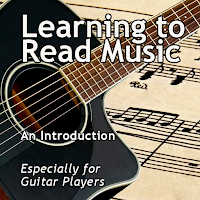Want to publish something in one of our blogs?
If you blog about teaching or learning music, or if you have a website about teaching music, learning a musical instrument, or any aspect of music theory, why don't you submit something for publishing in this blog.
It's a great way to get personal exposure as well as free promotion for your blog, website or music-related products or service.
If you are interested Check It Out Here.
Friday, March 22, 2019
Wednesday, March 20, 2019
Learning to Read Music - Part 1 - Overview of the Staff
The musical staff is the basic framework for traditional music notation. The staff consists of a series of five parallel lines. The sequence of musical notes that make up a song are then placed along these lines. The two dimensions represented on the staff are pitch and time.
Pitch - whether a note sounds "high" or "low" - is represented by placing notes higher or lower in the series of staff lines.
Time - There are actually two different components to the time dimension of music. Every piece of music has a beat which varies from song to song, and sometimes within the same song. This is called the tempo of the music.
 Tempo is normally measured in terms of beats per minute (bpm), and is indicated at the very beginning of the first staff line of a composition. In our example the tempo is indicated as 80 beats per minute. And this tempo is maintained unless a different tempo is indicated.
Tempo is normally measured in terms of beats per minute (bpm), and is indicated at the very beginning of the first staff line of a composition. In our example the tempo is indicated as 80 beats per minute. And this tempo is maintained unless a different tempo is indicated.Thursday, March 14, 2019
Sometimes Playing on Fewer Strings is Better
When I work with a new student who is learning guitar from scratch we first play 4 string versions of G, C and D because they are a bit easier to play.
The fact is though, that these chords where you don't use all the strings may actually sound better than "full" chords in some cases.
For example a 4 or even 3 string version of D lets you highlight the higher strings. And an A (or even more commonly, a B chord) played on strings 4, 3 and 2 - where you don't play string 1, can sound perfectly adequate when used the right way.
Rock guitarists actually use two string combinations a lot. So-called "power chords" are 2 string chords played on the lower strings like the well known riff from "Smoke on the Water". And "double stops" are two string combinations played on the higher strings (a la Chuck Berry).
The bottom line is that a "chord" is not always played by strumming across all six strings. To get the best sounding string combinations you need to strike the most appropriate strings.
For example a 4 or even 3 string version of D lets you highlight the higher strings. And an A (or even more commonly, a B chord) played on strings 4, 3 and 2 - where you don't play string 1, can sound perfectly adequate when used the right way.
Rock guitarists actually use two string combinations a lot. So-called "power chords" are 2 string chords played on the lower strings like the well known riff from "Smoke on the Water". And "double stops" are two string combinations played on the higher strings (a la Chuck Berry).
The bottom line is that a "chord" is not always played by strumming across all six strings. To get the best sounding string combinations you need to strike the most appropriate strings.
Subscribe to:
Posts (Atom)



